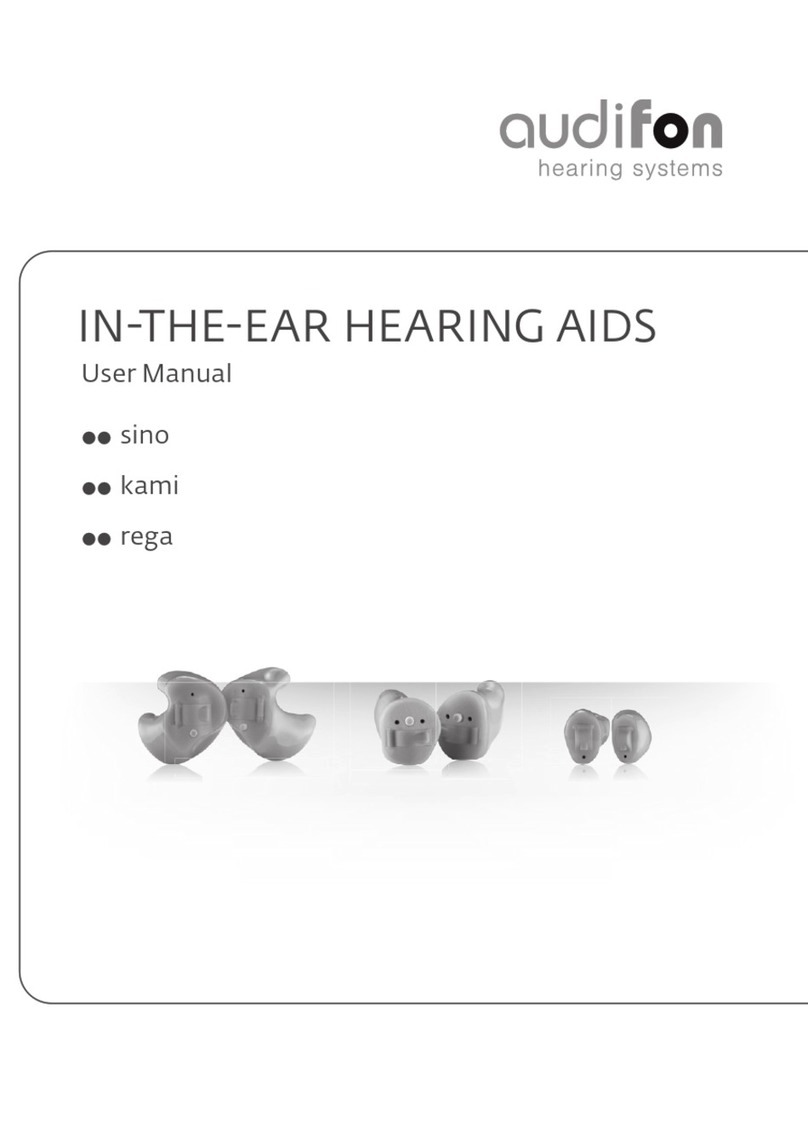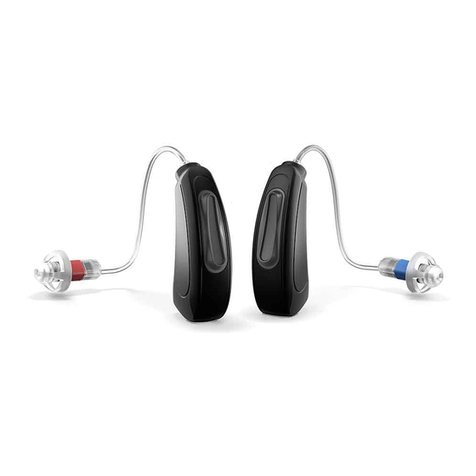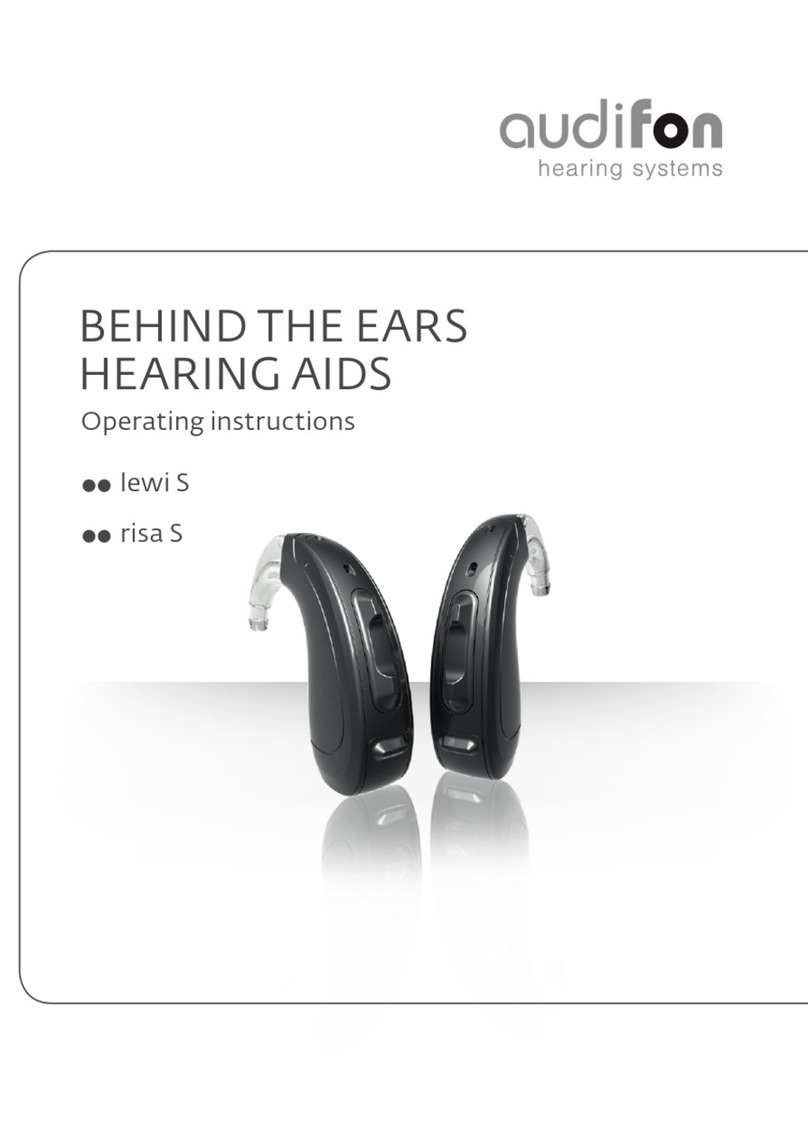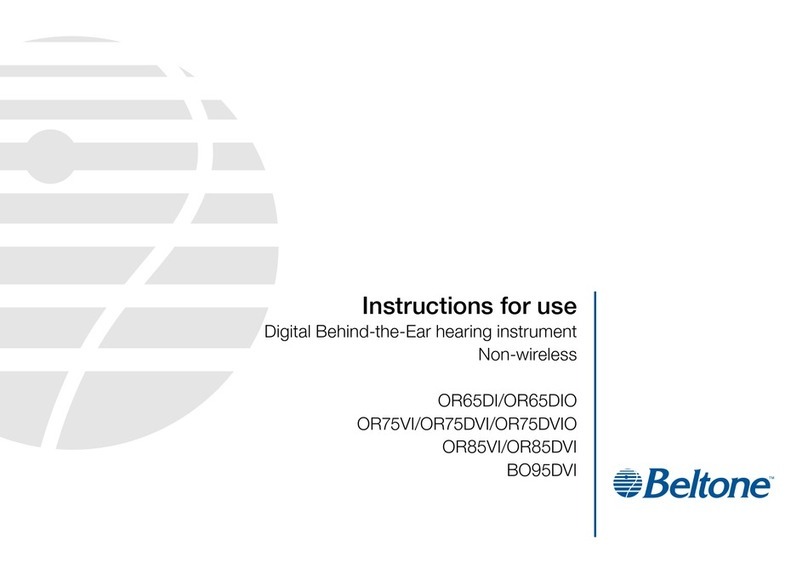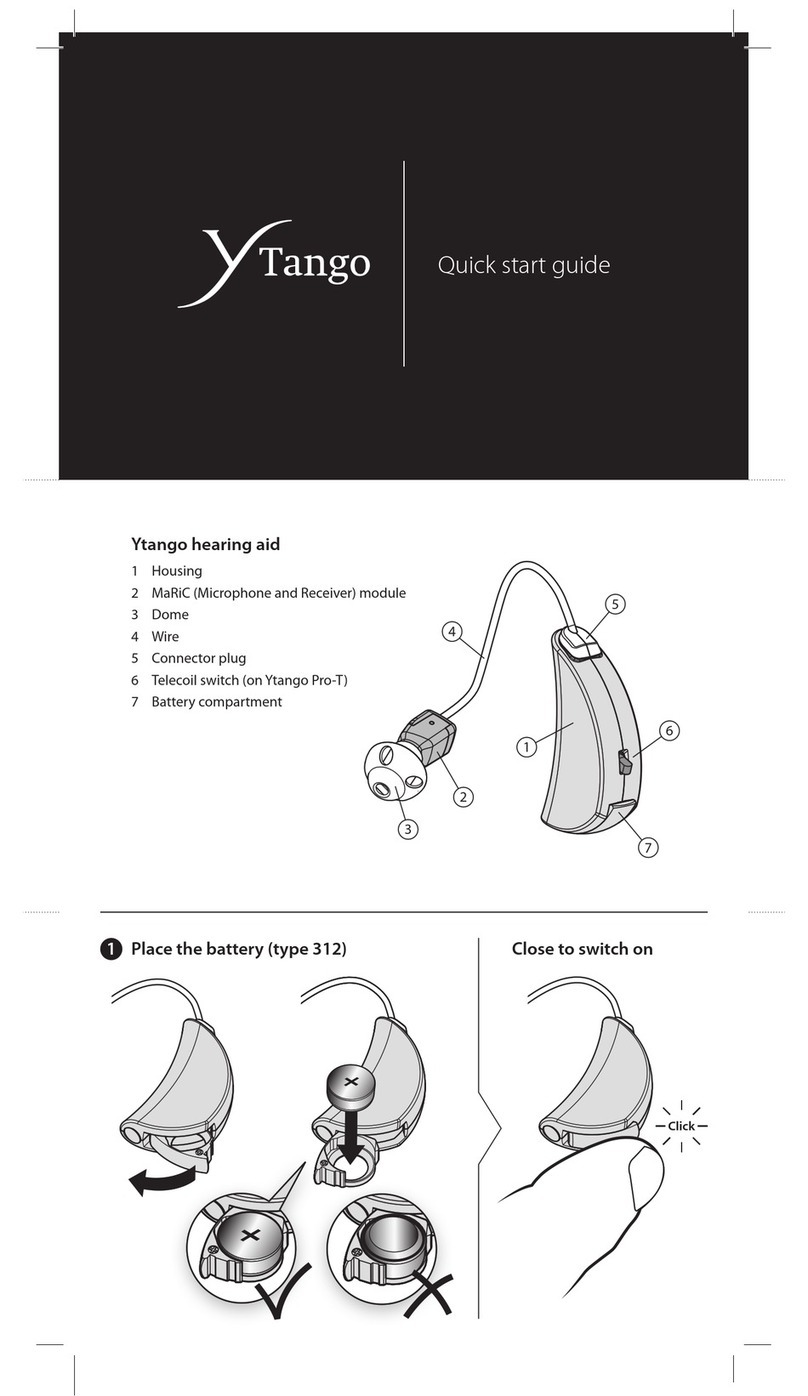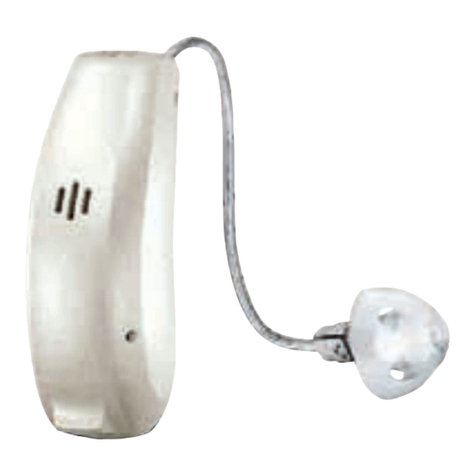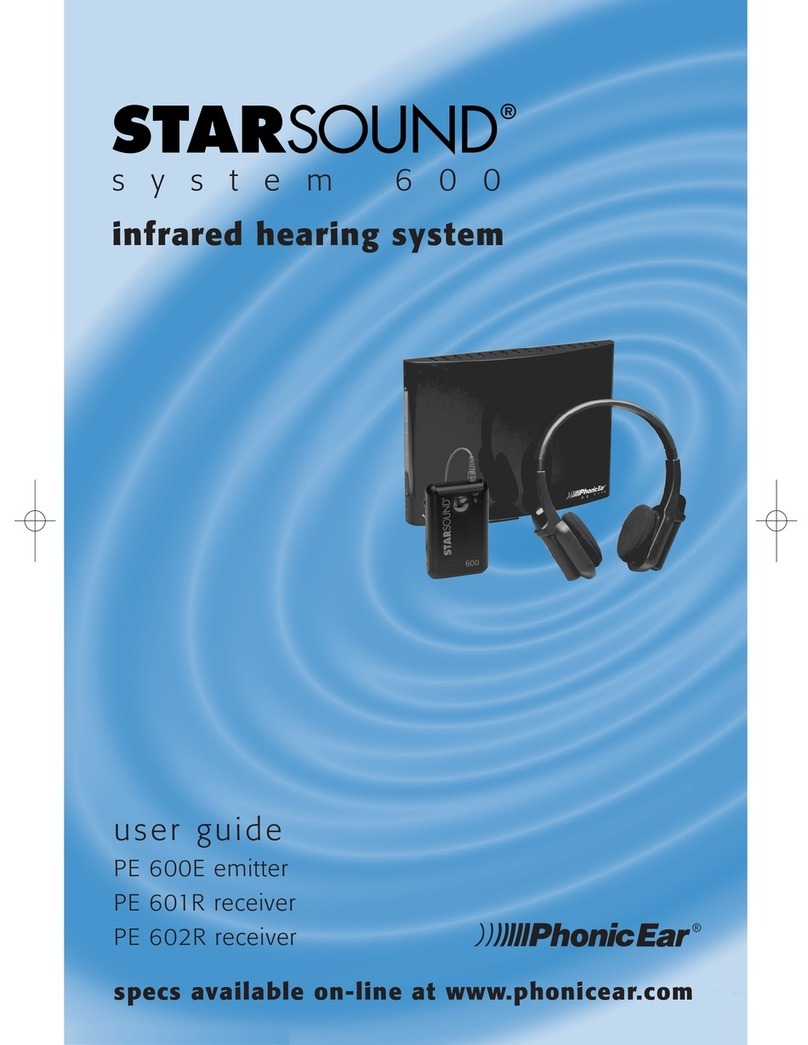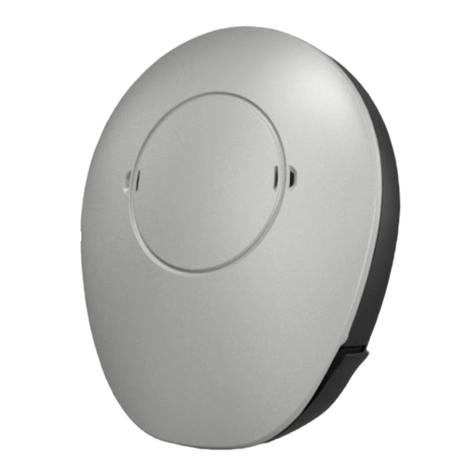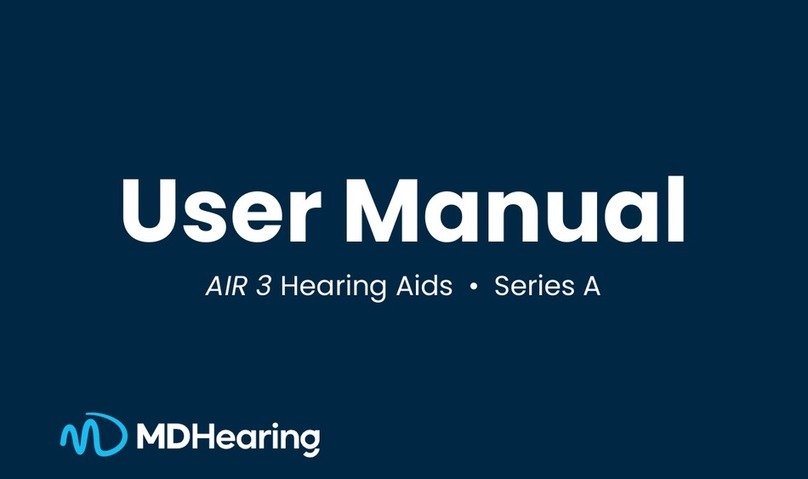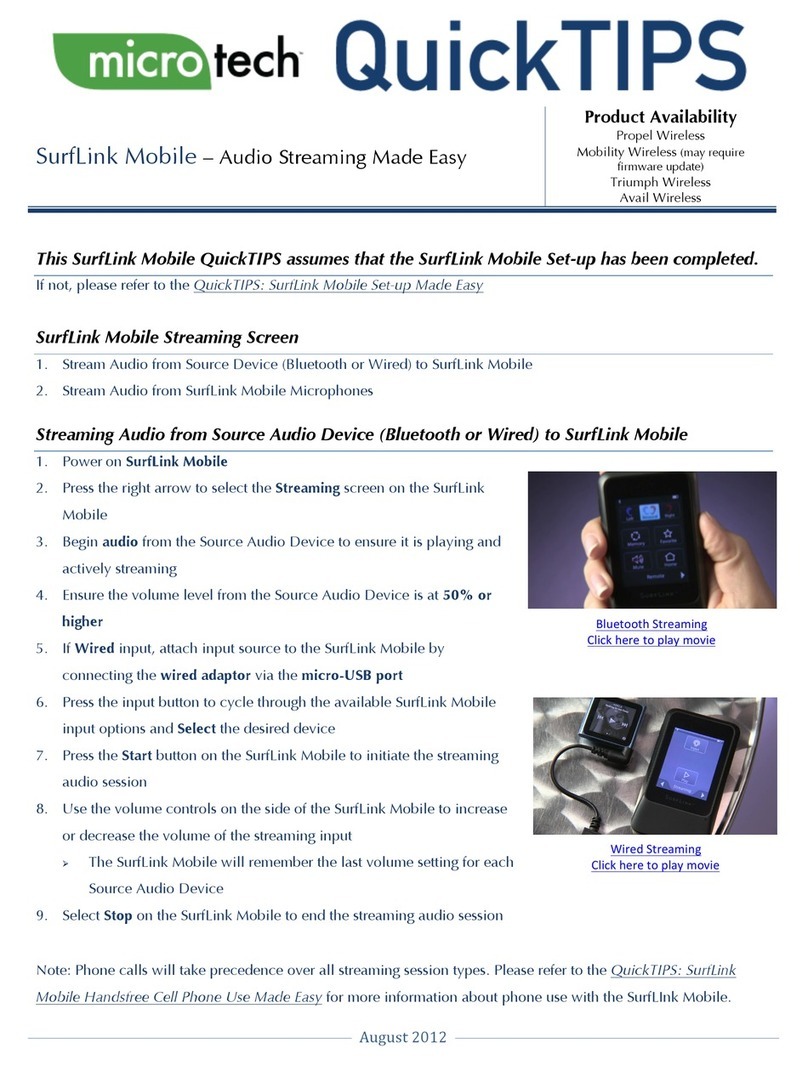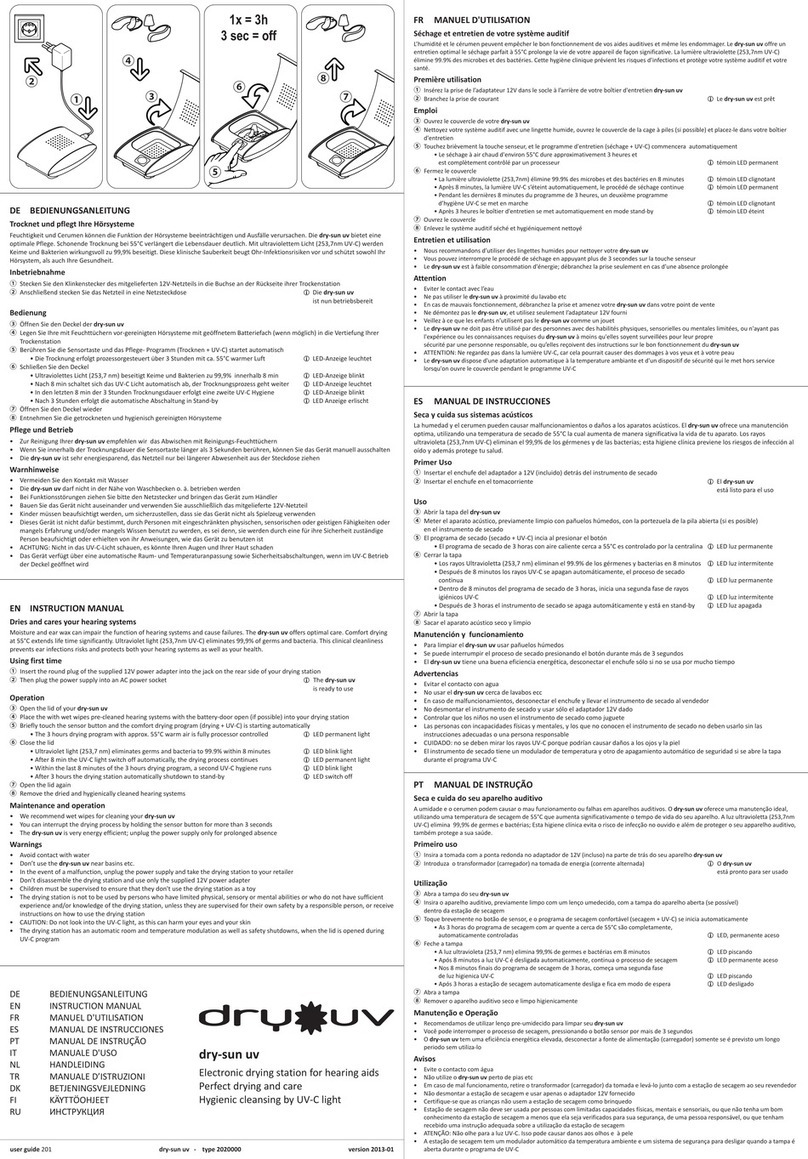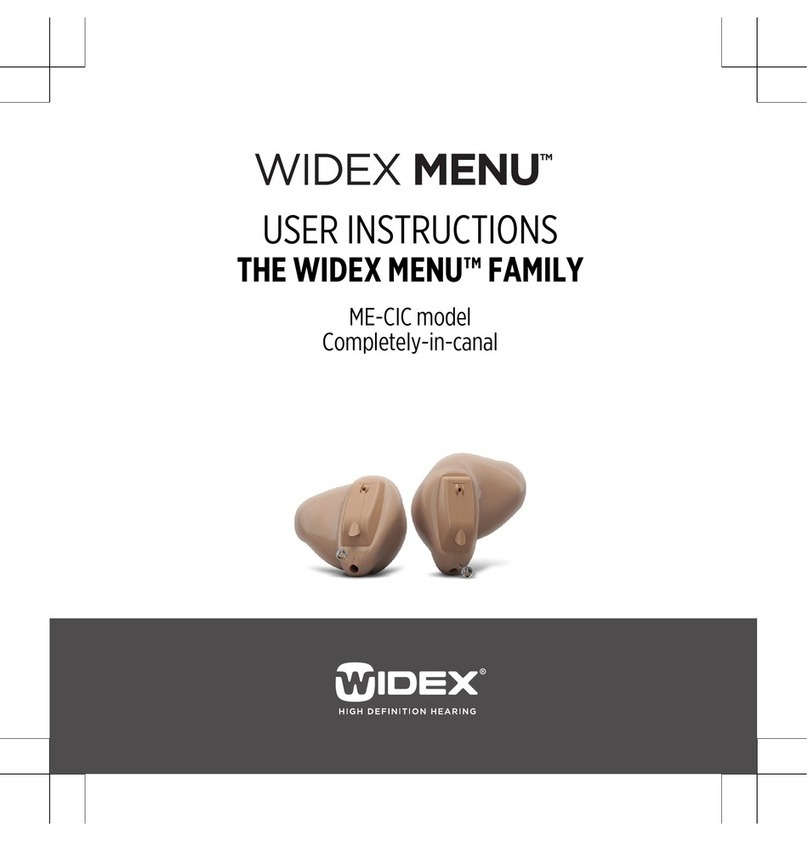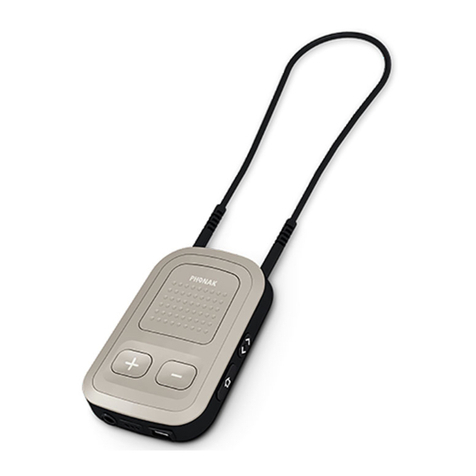Audifon sino R User manual

BEHIND-THE-EAR HEARING AIDS
sino R
kami R
rega R
User Manual

3
CONTENTS
INTRODUCTION ...............................................................
YOUR HEARING AID ..........................................................
. Type ...........................................................................
. Overview.....................................................................
. Batteries......................................................................
.. Information on battery........................................
.. Low battery warning...........................................
OPERATION SINO R, KAMI R, REGA R.............................
. Construction ...............................................................
. Inserting battery..........................................................
. Removing batteries .....................................................
. Switching hearing aids on and o.................................
. Inserting and removing hearing aids ............................
.. Inserting the hearing aids....................................
.. Removing hearing aids ........................................
. Volume control and program selection ........................
.. Multifunctional rocker switch .............................
.. Volume selection.................................................
.. Selecting hearing programs.................................
TINNITUS FUNCTION........................................................
MAKING PHONE CALLS .....................................................
. Telephone loop TCoil ................................................
. Automatic program change .........................................
.. Auto TCoil ..........................................................
.. Auto Phone .........................................................
.. Attaching magnet ...............................................
ACCESSORIES....................................................................
CARE INSTRUCTIONS .......................................................
Updated: 09.08.2021
Intended purpose
Hearing aids reduce the eects of hearing loss as much as
possible. Personal discomfort thresholds in loud noises are also
taken into account.
In quiet environments as well as in situations with background
noise, speech intelligibility should be improved and hearing
eort reduced.
The hearing aids are designed to last 6 years. Further
restrictions on use are listed in section 9 Safety instructions.
Hearing aids and the noiser module must be individually
fitted by a hearing care professional or an ENT doctor.

54
INTRODUCTION
Congratulations on the purchase of your new audifon hearing
aids. Your hearing care professional has set this for your individu-
al requirements. These instructions are therefore intended to
help you use your audifon hearing aids properly.
Please read through the following operating and care instruc-
tions carefully to avoid malfunctions and damage. If you follow
the instructions, your hearing aids will prove an invaluable help
in day-to-day communication in your surroundings and with
other people.
The specific model of your hearing aids is shown on the sticker
on the packaging, on the warranty card or printed on the
hearing aids themselves.
A hearing aid cannot restore your hearing to normal or cure your
hearing loss and neither will it make your hearing worse. How-
ever, a hearing aid will go a long way to restoring normal hearing
levels for many of those activities you may have been missing
out on. Hearing aids are the treatment of choice for most types
of hearing loss.
If you have any further questions, please contact your hearing
care professional.
. General .......................................................................
. Cleaning and care of behindtheearhearing aids
with external receiver .................................................
. Changing earwax protection filter...............................
. Drying hearing aids......................................................
TROUBLESHOOTING ........................................................
SAFETY INFORMATION.....................................................
. Important warnings....................................................
. Information about product safety ...............................
SIDE EFFECTS AND CONTRAINDICATIONS .......................
. Side eects ................................................................
. Contraindications ......................................................
OPERATING CONDITIONS.................................................
TRANSPORT AND STORAGE CONDITIONS .......................
ENVIRONMENTALLY COMPATIBLE DISPOSAL ...................
OTHER INFORMATION .....................................................
. EU declaration of conformity......................................
. FCC Statement...........................................................
SERVICE ...........................................................................
KEY TO SYMBOLS ..............................................................
WARRANTY CARD

76
.. Information on battery
A zinc air battery is used to supply the power for your hearing
aids. This type of battery is only activated when oxygen comes
through the air holes into the button cell and a chemical
reaction is initiated. During production, the air holes are sealed
with a protective strip.
This ensures the battery remains fresh until use and lasts longer
when it is sealed. Removing the protective strip allows oxygen
to enter and the chemical reaction is initiated.
. Batteries
To start your hearing aids, first insert a battery in the battery
compartment.
Make sure you only use zinc air batteries. Please follow the
instructions on the battery packaging. For the exact type of
battery in your hearing aid please see the overview table.
Always switch your hearing aid OFF after use. To avoid damage,
remove the battery if you are not using your hearing aids for a
long time.
YOUR HEARING AID
. Type
Your hearing aids are behind-the-ear hearing aids with an
external receiver. The receiver is located directly in your ear.
. Overview
This user manual applies to the following types:
Detailed acoustic data for your hearing aid can be found
in a separate data specification. This and further information
are available from your hearing care professional or
www audifon.com.
Model
sino R
kami R
rega R
mild to severehearing loss
mild to severehearing loss
mild to severehearing loss
Indication range
Size
Average
service life
(zinc air) in h
Gain in dB
Battery
HE S HE M HE S HE M

98
4
5
6
3
2
1
OPERATION SINO R, KAMI R, REGA R
Your hearing aid consists of the following elements:
The hearing aids have markings for the sides:
blue = left, red = right
Your hearing aids may dier from the illustrations.
Receiver module
Domes or ear molds
Concha clip optional
Microphone inlets
Multifunctional rocker switch
Battery compartment / ON/OFF switch
. Construction
1
2
3
6
5
4
Important warnings
Refitting the strip when the battery is not in use will not
extend its service life.
Battery should be stored at room temperature. Avoid
keeping them in hot places or rooms with high humidity
(e.g. bathroom). Storage in a cooled location is not
necessar y.
Used batteries are considered hazardous materials and
contain toxic materials, should never be disposed of in the
trash. Ask about recycling programs in your area where
you live or return them to your hearing care professional to
dispose them appropriately.
Further safety instructions can be found on the battery
packaging.
.. Low battery warning
An audible signal indicates the end of the battery life
(approx. 30 minutes before the battery runs out).

1110
Open the battery compartment carefully
with your fingernail at the edge for opening
and swing it right out.
Then remove the battery from the battery
compartment.
. Removing battery
Please do not open the battery compartment any wider
than shown in Section 3.2. This might damage the device.
Remove a battery from its packaging.
If the battery has a protective film,
remove it and wait a few minutes before
inserting the battery.
Open the battery compartment carefully
with your fingernail at the edge for opening
and swing it right out.
Please do not open the battery
compartment any wider than shown
here. This might damage the device.
Then insert the battery in the battery
compartment. Make sure the (+) symbol on
the battery matches the (+) symbol on the
battery compartment.
. Inserting battery
NOTE:Do not force the battery into the battery
compartment. If it does not fit, check whether you are
inserting it correctly and that it is the correct type of battery
(see Section 2.2).

1312
.. Inserting the hearing aids
Place the hearing aid behind your ear.
. Inserting and removing hearing aids
Concha clip
(optional)
Receiver module
Hearing aid
Slide the receiver unit carefully into your ear canal.
Rotate slightly until it is positioned properly.
Open and close your mouth to avoid air being trapped in the
ear canal.
The hearing aids are marked left and right:
blue = left, red = right
Switching OFF
To switch the device OFF, press the battery
compartment out to the first catch position.
This is the OFF position.
If the devices are going to be out of use for a
long time, open the battery compartment
fully and remove the battery.
Switching ON
Close the battery compartment securely
with a battery inserted by moving it past the
catch of the OFF position into the casing.
You will feel the battery compartment
clicking into place as you close it.
The hearing aids are now switched ON.
After a preset delay and a start-up jingle,
the first program will activate and the
hearing aids are ready for use.
. Switching hearing aids ON and OFF
Your hearing aids are switched on and o via the battery
compartment.

1514
Your hearing aids feature a multifunctional
rocker switch for controlling the volume and
selecting the dierent programs. The rocker
switch can be activated by pressing the
top (+) and bottom end (-).
. Volume control and program selection
.. Multifunctional rocker switch
The rocker switch can be programmed with one of three
functions. Your hearing care professional has marked here
which of the functions has been set for your hearing aids:
Volume control
To control the volume, press the multifunction rocker
switch briefly on the top or bottom also see ...
Program selector switch
To change the program, press the multifunction rocker
switch briefly on the top or bottom also see ...
Volume control and program selector switch
combined
To control the volume, press the multifunction rocker
switch briefly on the top or bottom; to change the program
hold the switch down for approx. second see also ..
and ...
The optional Concha-Clip helps improve the fit
of the receiver unit in the ear.
To position the Concha-Clip, bend slightly and
place the Concha-Clip carefully in the outer
part of your ear.
Switch the hearing aid on by closing the
battery compartment securely.
Caution: Risk of injury!
Always wear the receiver module with its
dome or PowerSleeve and check that they
are positioned securely on the tube.
Warning: Risk of injury!
In some very rare cases the dome may remain in the ear
canal on removal. Should this happen, please contact your
doctor or hearing care professional at once. Please do not
try to remove the dome yourself
Lift your hearing aid and slide it carefully over the outer part
of your ear. Carefully pull the tube with the earpiece out of the
ear canal. Switch the hearing aid o by moving the battery
compartment to the OFF position.
.. Removing the hearing aids

1716
Hearing program
Description of setting
.. Selecting hearing programs
Multifunctional rocker switch
Your hearing care professional will have adjusted your hearing
aids to various hearing situations with you and assigned them
to specific hearing programs.
+ switch:
switch:
Program change sequence*:
The rocker switch allows you to swap
between the hearing programs. To do so,
simply hold down one end of the rocker
switch until you hear audible confirmation
of the change in program. The number of
signals indicates the number of the program
selected. You can move up or down through
the hearing situations.
Volume control and program selection are optional
functions. Your hearing care professional will adjust your
devices to your individual requirements.
* Example with three hearing programs
.. Volume selection
The volume can be adjusted in steps using
the rocker switch. Briefly pressing the top
end of the switch increases the volume,
while briefly pressing the bottom end
reduces the volume.
When you switch your devices on, they will
be at the volume set for you. You can now
increase or reduce the volume in steps.
Each time you press the switch, you will
hear audible confirmation.
Once you have reached the upper or lower
volume limit, you will hear a clear signal.
Volume control and program selection are optional
functions. Your hearing care professional will adjust your
devices to your individual requirements.

1918
TINNITUS FUNCTION
Combi hearing aids from audifon play an eective part in
tinnitus therapy.
Your hearing care professional would have adjusted the combi
hearing aids to your individual hearing situation with you.
Information on operating devices with active tinnitus modules
can be found in Section 3 on this user manual.
. Intended purpose
The integrated noiser module can be optionally activated and
can be used to support tinnitus therapy.
In combination with other therapeutic measures, the noise is
intended to help reduce the perception of tinnitus.
Activation of the noiser module as part of a tinnitus therapy
is suitable for adults aged 18 and over.
MAKING PHONE CALLS
. Telephone loop TCoil*
A telephone loop receives the magnetic signal from telephones
and converts it to sound. This optional telephone program may
help you to understand better what people are saying on the
telephone.
When making calls with the telephone loop program, hold the
handset as normal.
To find the correct position for optimum reception, move
the handset backwards and forwards slightly.
. Automatic program change*
The hearing aids belonging to the kami and rega families feature
automatic telephone program activation. The hearing aids can
automatically switch either to telephone loop (Auto T-Coil) or to
a microphone program for telephony (Auto Phone).
To prevent the hearing aids from accidentally switching
programmes during a telephone call, the program switch is
disabled during this time.
Depending on which type of hearing aid you have, it may not
feature the elements marked with an *.

2120
.. Auto TCoil
Automatic switchover to the telephone loop program is
designed for landline phones and only works with older
telephones or phones which have been specially designed
for use with telephone loops. Attaching the optional magnet
sticker increases the reliability of the switching function.
Familiarise yourself with how the automatic telephone loop
switching function works before making a call.
When you move the telephone handset away from your ear
again, your hearing aids will return to the program previously
in use.
.. Auto Phone
Automatic switchover to an acoustic telephone program can
be used with conventional landlines and mobile phones and
optimises playback for telephony. Attaching the optional
magnet sticker increases the reliability of the switching
function. Familiarise yourself with how the automatic
telephone program switching function works before making
a call.
When you move the telephone handset away from your ear
again, your hearing aids will return to the program previously
in use.
.. Attaching magnet
To attach the magnet, proceed as follows:
. Clean the telephone handset thoroughly.
. Attach the magnet as shown in the illustration.
. If necessary, you can reposition the magnet.

2322
The hearing aids from the sino, kami and rega families oer the
following accessories, which are available from your hearing
care professional.
For further information please contact your hearing care
professional.
ACCESSORIES
Accessories
UniTip Soundshell
UniTip domes
UniTip receiver
module SM
Conchaclip
CeruStop filter
Individual ear adapter piece for your hearing aids
Universal earpieces for use with your hearing aids
the receiver module is used to emit the amplified sound
into the ear canal
Fastens the UniTip receiver modeul in the ear canal
Small filter that protects the ThinTubes from blockages
and that should be replaced regularly
Description
CARE INSTRUCTIONS
audifon hearing aids will improve your hearing ability as well as
your quality of life. To ensure your hearing aids function perfectly
and so make hearing a pleasant experience for years to come,
audifon oers special care products that will enable optimum
cleaning of your devices.
Protect your hearing aids from moisture (e.g. showers, sweat,
rain) and also take your hearing aids out before using hairspray or
similar cosmetic products.
We also recommend you carry out daily care on your hearing aids
as they are exposed to moisture and dust during proper use, even
when handled with care.
Whatever type of hearing aid you use: Each one is in direct contact
with the skin. This produces perspiration, which may damage
your hearing aid in the long term unless dried on a daily basis.
audifon’s behind-the-ear hearing aids are coated with a water-
repellent finish to prevent any damage from moisture.
Wearing a hearing aid or insertion of the ear adapter piece in the
ear canal will always involve soiling with earwax. For this reason
we recommend regular cleaning. Earwax can build up at the
sound outlets, particularly with hearing aids with an external
receiver, and so aect sound quality.
Should your hearing system still not function correctly despite
regular care, call on your hearing care professional. Do not try
under any circumstances to repair your hearing aid yourself.
. General

2524
. Cleaning and care of behindtheearhearing aids with
external receiver
Hearing aids with an external receiver have special requirements
in terms of cleaning and care. Please proceed as follows:
To clean your hearing aids on the outside, either use an audifon
pro care Cleaning-Tissue or a dry, lint-free cloth which you have
moistened with the audifon pro care Cleaning-Spray. Rub your
behind-the-ear hearing aid carefully with a tissue or cloth.
This will remove soiling and residues of earwax quickly and
easily. When handling the external receiver, please take special
care. Make sure that moisture does not get into the microphone
inlets of the hearing aid.
. Changing the earwax protection filter
Hearing aids with an external receiver feature protection filters
to prevent earwax being deposited inside the receiver. It is
necessary to regularly change the filter to ensure your hearing
aids function perfectly. To replace the filter, proceed as follows:
First remove the dome from the receiver
module and clean it.
Remove the replacement tool from the
filter dispenser and slide it into the filter.
Pull out the filter with a gentle turning
motion.
Turn the changing tool. At the other end of
the changing tool is a new filter.
Press the new filter with the changing tool
into the filter opening of the hearing aid
until it clicks into place. Then simply pull
out the replacement tool and dispose of it.

dry go
The audifon dry go is the perfect solution for drying your
devices when on trips or if out and about. Once connected,
for example to the USB port on your laptop, the drying
program can be conveniently started at the touch of a single
button. A flow of warm air inside the audifon dry go will
then dry your devices reliably. The drying
station switches o automatically
at the end of the drying
program.
dry star UV
The audifon dry star UV will dry your devices gently yet
thoroughly through a constant circulation of uniformly warm
air inside the casing.
The audifon dry star UV is not only automatic but also
consumes very little power, switching itself o at the end of the
drying program. The drying station is simple to operate using a
single sensor button.
. Drying hearing aids
Your hearing aids should be dried after use at the end of the day
and above all after cleaning. If you take care of your hearing aids
by drying them carefully, this will significantly increase their
service life. There are two ways of doing this. If you have an
audifon drying station of the type dry star UV 2 or dry go, use
this for drying. Take note of the individual product instructions
for further details. Alternatively, you can dry your hearing aids
in the audifon pro care Drying-Tub with an audifon Drying-
Capsule.
2726

2928
TROUBLESHOOTING
If you experience any malfunctions when using your hearing
aids, this does not necessarily mean that they are faulty.
Therefore, first check your hearing aid to make sure that:
•the hearing aid is switched on (see “Switching on and o”
Section 3.4),
•the batteries are not weak or dead,
•the volume control is not at the lowest setting (increase the
volume slightly if necessary),
•the right program has been set (change program if
necessary),
•the receiver unit/earwax protection system is not blocked.
If this does not eliminate the fault, consult your hearing care
professional, who will be pleased to help you.
Note: Malfunctions!
Your devices may be subject to interference from other electrical
equipment despite their EMC-compatible design. In this case
move away from the source of interference.
Warning: Risk of suocation!
Batteries, hearing aids and other small parts can be swallo-
wed. For this reason, these hearing aids are not intended for
use by children under 36 months of age. Never leave children
unattended with your hearing aids! Should a battery,
hearing aid or other small parts be accidentally swallowed,
please consult a doctor immediately.
Warning: Risk of injury!
In some very rare cases the dome may remain in the ear
canal on removal. Should this happen, please contact your
doctor or hearing care professional at once. Please do not
try to remove the dome yourself.
Warning: Damage to hearing!
The maximum volume of the noiser modul is in a range that
may lead to hearing loss according to OSHA regulations.
For users without hearing loss, the noiser modul should not
exceed sound pressure levels above 70 dB SPL (as measured
at a 2cc coupler). For users with hearing loss, the hearing
loss needs to be taken into consideration when adjusting
the noise levels. Under no circumstances should the noiser
module be used at a volume that is uncomfortable to the
user.
For sound pressure levels up to 80 db SPL (as measured at
the 2cc coupler) the noiser module can be used for up to 8
hours daily. For higher sound pressure levels, the uncritical
duration of applications is reduced. The noiser modul should
not be used for more than 2 hours daily at higher sound
pressure levels.
SAFETY INFORMATION
. Important warnings

3130
Higher sound levels and/or longer times of application
might harm the hearing ability over time.
Warning: Risk of explosion!
Do not use hearing aids in environments where there is a
risk of explosion (e.g. in mines or industrial plants subject to
such risk).
Warning: Risk of injury!
Hearing aids are adjusted to the individual hearing loss
of each wearer and should therefore only be used by this
person.
If the hearing aid is worn by other persons, this may harm
their hearing.
Warning: Risk of injury!
Please only use genuine consumables specified by the
manufacturer (dome, tubing, etc.) and accessories.
Unauthorised changes or modifications that have not been
explicitly approved can result in injury in the worst-case
scenario.
Warning: Interference with active and inactive
implants!
If you have an active or inactive implant (e.g. defibrillator,
pacemaker), follow the implant manufacturer's instructions
regarding the use of mobile devices. In the event of
malfunctions, stop using your hearing aid and contact your
doctor or the implant manufacturer.
If you have an active brain implant, ask your doctor or the
implant manufacturer for a risk analysis.
Warning: Risk of injury!
Always wear your reciever unit with the appropriate Dome
or customized earmold and check that they are securely
positioned on reciever unit.
. Information about product safety
Note: Interference with electronic devices!
If you are in an environment where use of electronic or
wireless devices is restricted, check whether your hearing
aids must be turned o.
Note: Damage to hearing aid!
Hearing aids are susceptible to impact, so avoid any hard
knocks (e.g. by dropping them).
Note: Damage to hearing aid!
To avoid damage to your hearing aids, please do not wear
them in the following situations:
•when swimming, in the shower or bath
•when washing or blow-drying your hair
•when using hair spray, perfume, aftershave or body lotion
• during high-frequency heat therapy treatment
• when it is very hot or raining heavily
Should your hearing aid become damp, remove the battery
and dry the hearing aid in one of the drying containers
specified by the manufacturer. Do not dry your hearing aid in
the microwave under any circumstances.
Note: Modifications to the device!
No modifications should be made to the hearing aids unless
performed directly by the manufacturer.

3332
Note: Damage to the hearing aid!
Do not force the battery into the battery compartment. If it
does not fit, check whether you are inserting it correctly and
that it is the correct type of battery.
Note: Leaking batteries can damage your hearing aid!
If you are not going to use your hearing aid for a long time,
remove the battery to increase its service life, to avoid
leakage and to prevent corrosion to the battery contacts.
Note: Damage to the hearing aid!
Magnets pose a risk when they are placed close to magnetic
storage media. Please therefore keep magnets away from
such media (e.g. bank cards).
Note: Strong radiation can damage hearing aids!
Make sure you take out your hearing aids if you are
undergoing a CT or MRI scan, other magnetic field-based
examinations or radiotherapy.
Note: Damage to the hearing aid!
Never leave your hearing aid in the sun, near a naked flame
or in a hot vehicle. Otherwise your hearing aids might
become damaged.
Note: Damage to the hearing aid!
Never try to change the shape of your hearing aid, ear mould
or tubing yourself. Otherwise your hearing aids might
become damaged.
Note: Malfunctions!
Your devices may be subject to interference from other
electrical equipment despite their EMC-compatible design.
In this case move away from the source of interference.
Note: Interference with electronic devices!
If you are in an environment where use of electronic
or wireless devices is restricted, check if the tinnitus
instrument must be turned o.
Note: Age of user!
The hearing aids are not suitable for children under
36 months.
Note: Reporting serious incidents!
All serious incidents that occur involving the product
should be reported to the manufacturer and the competent
authorities in the member state in which the user and/or
the patient are registered.

3534
SIDE EFFECTS AND CONTRAINDICATIONS
. Side Eects
Please consult a doctor or hearing care professional at once if you
notice the following side eects:
•Sensation of a foreign body
•Build-up of earwax
•Skin irritation
•Dizziness
•Vomiting
•Headache
•Pain in or behind the ear
•Any subjective deterioration in your hearing or increase
in the tinnitus level
. Contraindications
Hearing aids should not be used under the following
circumstances:
•Hearing loss due to mainly neural deficits
•Insucient size/shape of the ear canal or malformations at
the ear that do not allow for easy insertion and retrieval of the
respective device.
•Adverse medical conditions of the outer ear and the ear
canal e.g., chronic inflammations, chronic skin irritations,
cholesteatoma
•Known allergies to any materials that have skin contact
Patients who are unable to operate the devices independently
require competent assistance. The use of hearing aids for
mentally impaired persons and for children should only be
done on the recommendation of a doctor. A comprehensive
risk assessment should be performed for the specific individual
case. Close supervision by a caregiver is recommended to ensure
proper use of the hearing instruments and to avoid accidental
swallowing of hearing instruments or parts thereof.
OPERATING CONDITIONS
•Relative humidity between 10% and 90%
•Operating temperature between 0 °C and 40 °C
•Air pressure between 500 and 1060 hPa
TRANSPORT AND STORAGE CONDITIONS
•Relative humidity between 10% and 60%
•Storage temperature must lie between -20 °C and 60 °C
•Remove battery for storage
•Store away from magnetic fields

3736
ENVIRONMENTALLY COMPATIBLE
DISPOSAL
In accordance with European defaults used electrical and
electronics devices may no more be given to the unsorted
waste. The symbol of the waste bin on wheels refers to the
necessity of separate collection. Please help with environmental
protection and see to it that this device is given to the for this
purpose designated systems of waste sorting if you do not use it
any longer.
GUIDELINE 2012/19/EU of the EUROPEAN PARLIAMENT AND
THE COUNCIL of July 04th 2012 about electrical and electronics
old devices.
Alternatively, you can return your worn-out hearing aids and
batteries to your hearing aid specialist for environmentally
friendly disposal. He is your contact in the disposal chain for
electronic waste.
OTHER INFORMATION
14.1 EU declaration of conformity
audifon hereby declares that the hearing aids sino R kami R and
rega R comply with the following regulations and directives:
93/42/EEC for medical devices
2011/65/EU RoHs for the reduction of hazardous substances.
RED directive 2014/53/EU on radio and telecommunications
terminal equipment
The declaration of conformity can be viewed at
audifon GmbH & Co. KG
Werner-von-Siemens-Straße 2
D-99625 Kölleda
and at www.audifon.com
All serious incidents involving the product that occur should
be reported to the manufacturer and to the responsible
authorities in the member state in which the user and/or
the patient are registered.

3938
14.2 FCC Statement
Federal Communications Commission Statement
This device complies with part 15 of the FCC Rules. Operation is
subject to the following two conditions:
(1) This device may not cause harmful interference, and
(2) this device must accept any interference received,
including interference that may cause undesired operation.
NOTE:
This equipment has been tested and found to comply with
the limits for a Class B digital device, pursuant to part 15
of the FCC Rules. These limits are designed to provide
reasonable protection against harmful interference in a
residential installation. This equipment generates, uses and
can radiate radio frequency energy and, if not installed and
used in accordance with the instructions, may cause harmful
interference to radio communications. However, there is
no guarantee that interference will not occur in a particular
installation. If this equipment does cause harmful interference
to radio or television reception, which can be determined by
turning the equipment o and on, the user is encouraged to
try to correct the interference by one or more of the following
measures:
• Reorient or relocate the receiving antenna.
• Increase the separation between the equipment and receiver.
• Connect the equipment into an outlet on a circuit dierent
from that to which the receiver is connected.
• Consult the dealer or an experienced radio/TV technician
for help.
SERVICE
Arrange for your hearing aids to be checked preferably quarterly
by a hearing care professional.
Date
Hearing care professional
Date
Hearing care professional
Date
Hearing care professional
This manual suits for next models
2
Table of contents
Other Audifon Hearing Aid manuals

Audifon
Audifon sueno pro S User manual

Audifon
Audifon sino S User manual
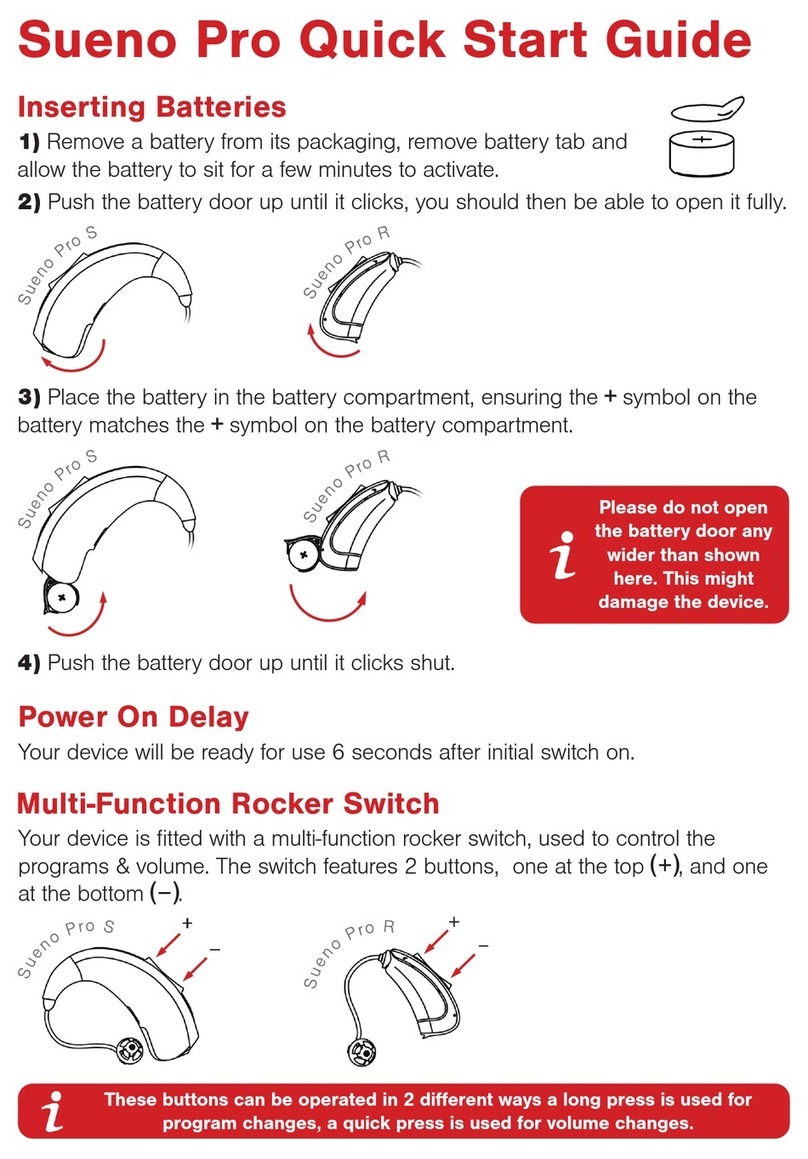
Audifon
Audifon Sueno Pro User manual

Audifon
Audifon MULTISTREAMER PRO User manual
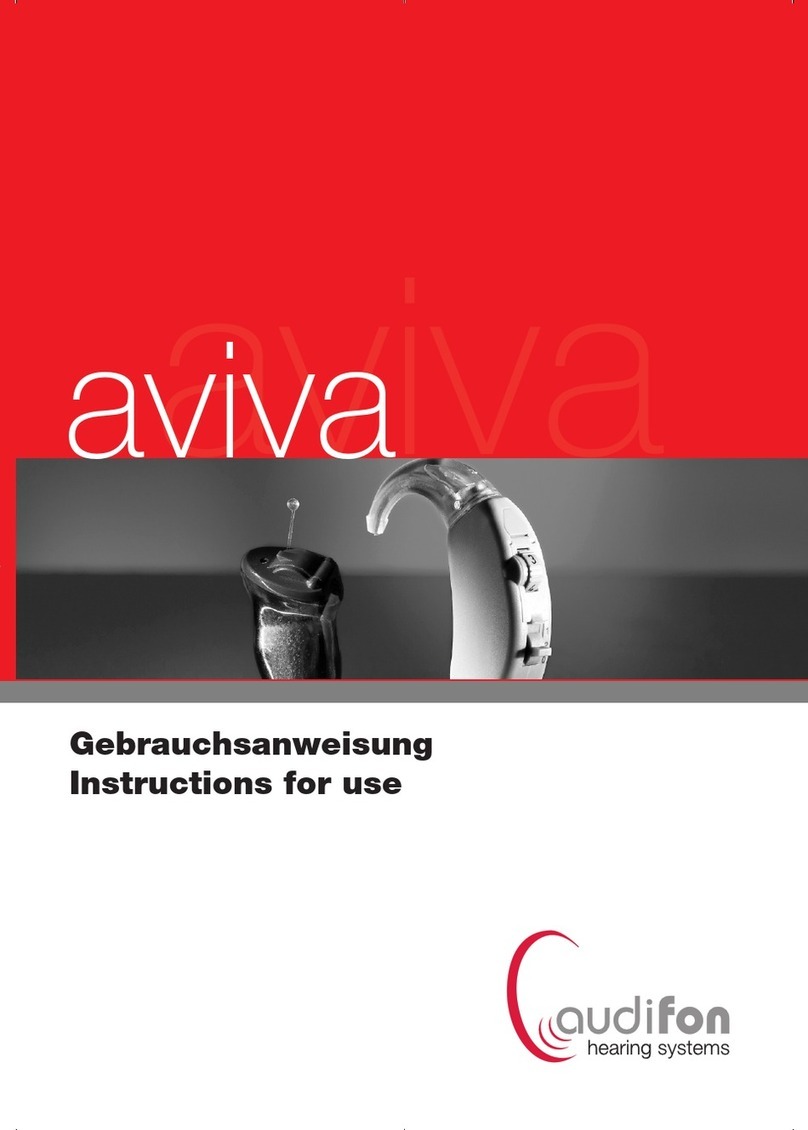
Audifon
Audifon aviva Series User manual

Audifon
Audifon lewi R User manual
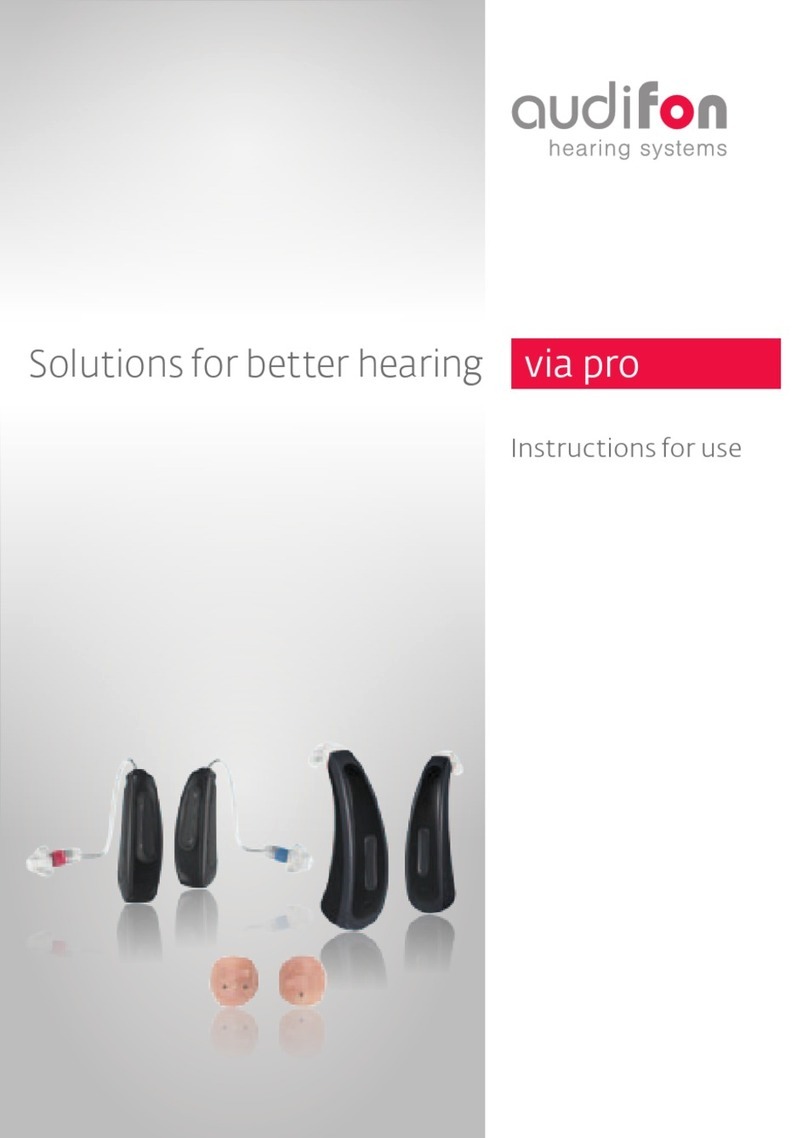
Audifon
Audifon via pro User manual

Audifon
Audifon eox M User manual

Audifon
Audifon lewi S User manual

Audifon
Audifon lewi S User manual
